Rats, often misunderstood and underappreciated, are intelligent and curious creatures that have captured the hearts of many animal enthusiasts around the world. In this article, we will explore the fascinating world of rats, where you can not only discover the beauty of these rodents through fun and interesting facts, but also unleash your own artistic talents by bringing these charming creatures to life with your choice of colors. Whether you’re a rat lover or simply looking for a unique and enjoyable coloring experience, join us on this colorful journey into the world of rat coloring pages.

You’re welcome to pick any design that captures your attention. Just select your favorite template, access the free PDF, print it out, and let your coloring imagination run wild without limits.
Moreover, these templates can double as guides for embroidery or serve as a wellspring of ideas for crafting intricate fine-line tattoos.
The potential is as boundless as your creativity allows it to be.
Rat facts
For newcomers to my coloring pages, it’s worth noting that I take pleasure in offering you the chance to immerse yourself in the topic.
This allows you to effortlessly turn your coloring session into an enriching educational adventure. Having said that, let’s get started!
Here are lots of fun and interesting, simplified, facts about rats:
- Intelligence: Rats are highly intelligent animals, often compared to the intelligence of dogs. They are capable of learning complex tasks and can even recognize their own names when called.
- Social Animals: Rats are social animals and prefer living in groups called colonies. They display strong bonds with their colony members, often grooming each other and sleeping in piles.
- Excellent Memory: Rats have impressive memory skills. They can remember the locations of objects and solve puzzles, demonstrating their ability to learn and adapt to new situations.
- Omnivorous Diet: Rats are opportunistic eaters and have a wide-ranging diet. They will eat almost anything, including grains, fruits, vegetables, insects, and even small vertebrates.
- Rapid Reproduction: Rats are known for their high reproductive rate. A single pair of rats and their offspring can produce up to 2,000 descendants in a single year if left unchecked.
- Nocturnal Creatures: Rats are primarily nocturnal, meaning they are most active during the night. This behavior helps them avoid predators and compete for food resources more effectively.
- Exceptional Swimmers: Rats are excellent swimmers and can hold their breath for up to three minutes. They can also tread water for extended periods.
- Keen Sense of Smell: Rats have a highly developed sense of smell, which they use for communication, navigation, and finding food. They can detect certain substances in extremely small quantities.
- Whiskers as Sensors: Rats use their long whiskers, or vibrissae, to navigate in the dark. These sensitive hairs help them detect obstacles and changes in their environment.
- Versatile Tails: Rats have long, scaly tails that serve various purposes. They use their tails for balance, communication, and regulating their body temperature. Some species can even wrap their tails around objects to hold onto them.
- Contributions to Science: Rats have been invaluable in scientific research. Their genetic makeup is similar to that of humans, making them ideal for studying various medical conditions and testing treatments.
- Cultural Significance: Rats have played significant roles in the cultures of many societies. In some Asian cultures, rats are associated with wealth and prosperity, while in others, they are seen as symbols of resourcefulness and adaptability.
- Hero Rats: African Giant Pouched Rats, also known as “Hero Rats,” have been trained to detect landmines and tuberculosis in some parts of the world, saving countless lives.
- Longevity: In the wild, rats have a relatively short lifespan, typically around one to two years. However, when kept as pets and provided with proper care, they can live up to three or more years.
- Variety of Species: There are over 60 species of rats worldwide, ranging in size from the tiny African Pygmy Mouse to the larger Gambian Pouched Rat.
These captivating creatures, with their adaptability, intelligence, and unique characteristics, continue to intrigue and inspire both scientists and admirers of the animal kingdom alike.
We learned lots about rats, but there’s much know to know.
If you would like to continue on your quest for rat-knowledge, here are some other reputable resources to check out.:
- https://en.wikipedia.org/wiki/Rat
- https://www.natgeokids.com/uk/discover/animals/general-animals/facts-about-rats/
- https://www.britannica.com/list/8-interesting-facts-about-rats
- https://www.onekindplanet.org/animal/rat/
- https://www.pbs.org/wnet/nature/blog/rat-fact-sheet/
- To see all of my free printables, go here.
- If you would like to see an alphabetized index of free printable coloring pages, go here!
- All of my animals coloring pages are found here.
- Or, my other mammals coloring pages can be found here.
Coloring tips
Coloring pictures of rats can be a delightful and creative experience.
Here are some of my best tips and tricks to help you bring these charming rodents to life:
- Reference Images: Start by finding reference images of rats. These can be photos or illustrations of real rats, which will help you understand their fur patterns, colors, and anatomy better.
- Choose the Right Colors: Consider the type of rat you want to color. Rats come in various colors, including brown, black, white, and shades of gray. Some have unique markings, like hooded rats with a colored head and shoulders. Choose your colors wisely based on your reference or your imagination.
- Layering Technique: When using colored pencils, markers, or crayons, use a layering technique. Start with light colors and gradually build up to darker shades. This adds depth and dimension to your rat’s fur.
- Blending: Blending is crucial for achieving a realistic look. You can use blending tools like blending stumps (for pencils) or a colorless blender (for markers). If you don’t have specialized tools, you can also use your fingers to gently blend colors together.
- Highlight and Shadow: Pay attention to light sources in your coloring. Add highlights to the areas that would catch more light, such as the top of the rat’s head and its back, and create shadows in areas that would be in shade, like under the belly and tail.
- Texture and Fur: Rats have soft, furry coats. To mimic this, use short, quick strokes or small circles to create a fur-like texture. The direction of your strokes should follow the direction of the fur.
- Background: Consider the background of your rat pages. A simple background can enhance your artwork. For example, you can draw a rat in a cage, in a garden, or with some cheese for added context and visual interest.
- Experiment with Mediums: Don’t limit yourself to just one coloring medium. Experiment with watercolors, colored pencils, markers, or even digital coloring if you have the tools. Different mediums can yield different effects and styles.
- Practice Patience: Coloring can be a time-consuming process, especially if you aim for intricate details. Be patient and take your time to ensure a high-quality result.
- Add Personal Touches: Feel free to add your own creative elements to the coloring page. Maybe your rat has a little accessory or is in a whimsical scenario. Adding personal touches can make your artwork more unique and fun.
- Share and Seek Feedback: Once you’ve completed your coloring page, consider sharing it with friends, family, or online communities. Constructive feedback can help you improve your skills.
- Enjoy the Process: Remember that coloring is a relaxing and enjoyable activity. Don’t stress over perfection. Embrace imperfections, and have fun expressing yourself through your artwork.
- Learn Rat Anatomy: If you want to take your coloring to the next level, consider studying rat anatomy. Understanding their bone structure and muscle placement can help you create more accurate and realistic depictions.
- Practice Regularly: Like any skill, coloring improves with practice. The more you color, the more you’ll refine your techniques and develop your unique style.
Coloring pictures of rats can be a rewarding and creative hobby.
Whether you’re a beginner or an experienced artist, these tips and tricks will help you create beautiful rat-themed artwork that reflects your personal style and imagination.
Options For Printing:
Letter R is for rat writing practice worksheets
*My letter R is for rat coloring sheet printables are exclusively crafted for classroom use, making them the sole printable selections on this page that don’t require written permission for public usage.
However, if someone asks where you got them, kindly share the link to this post with them. Your support is greatly appreciated!
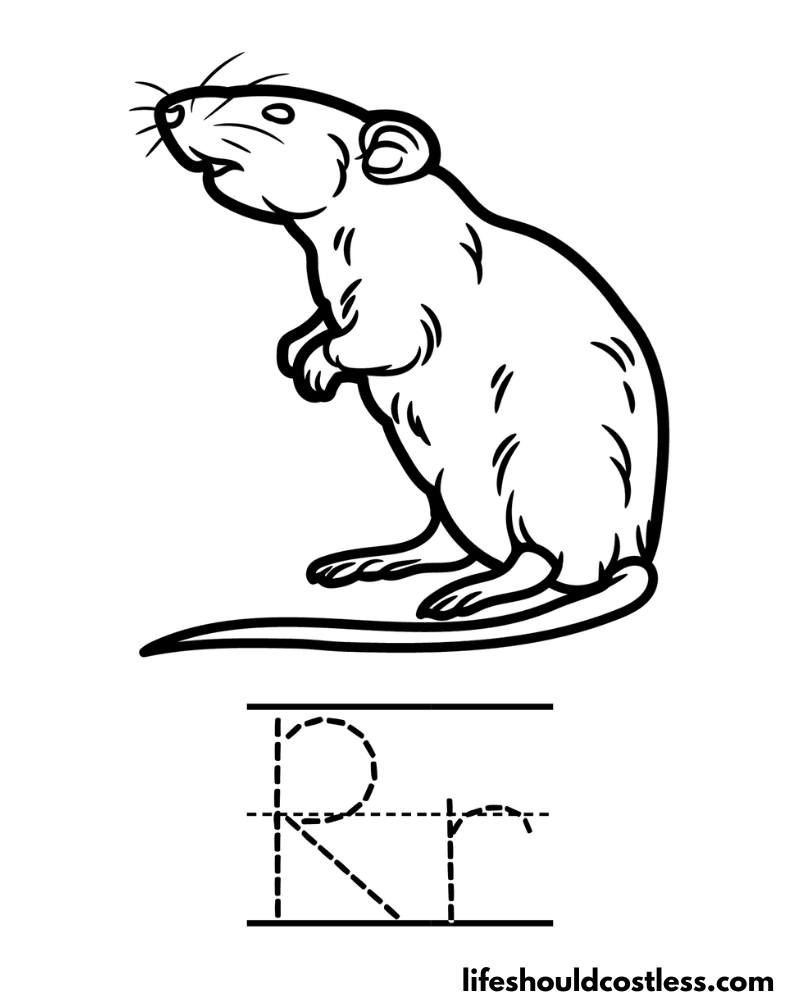
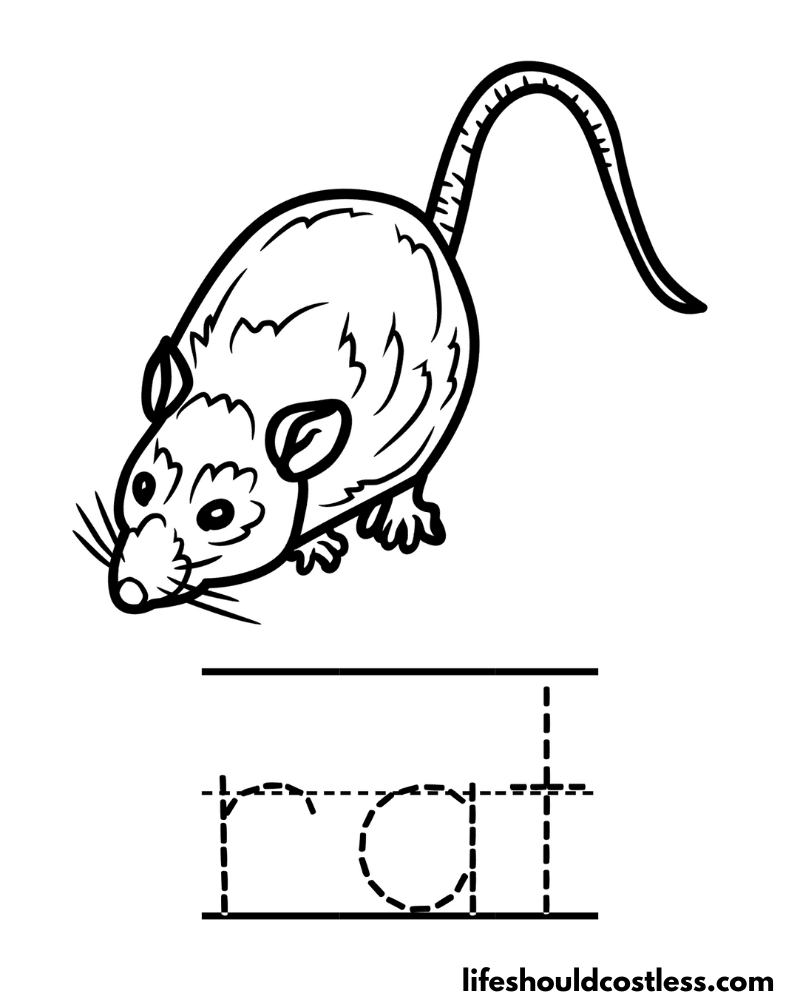
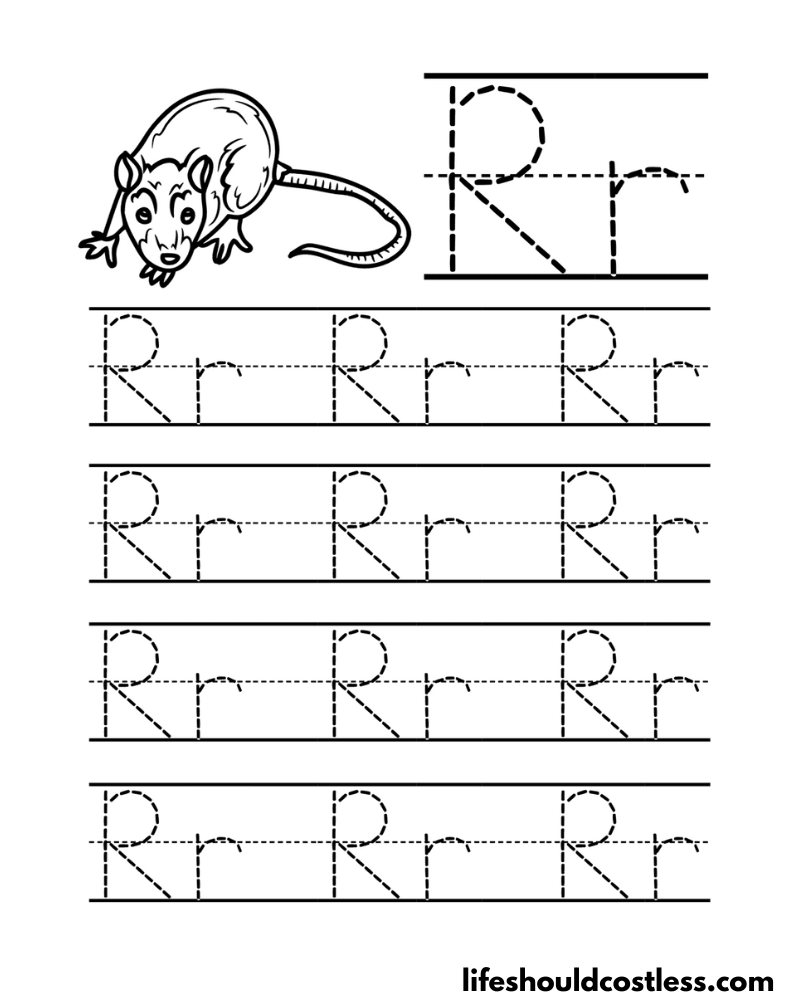
Various rat designs

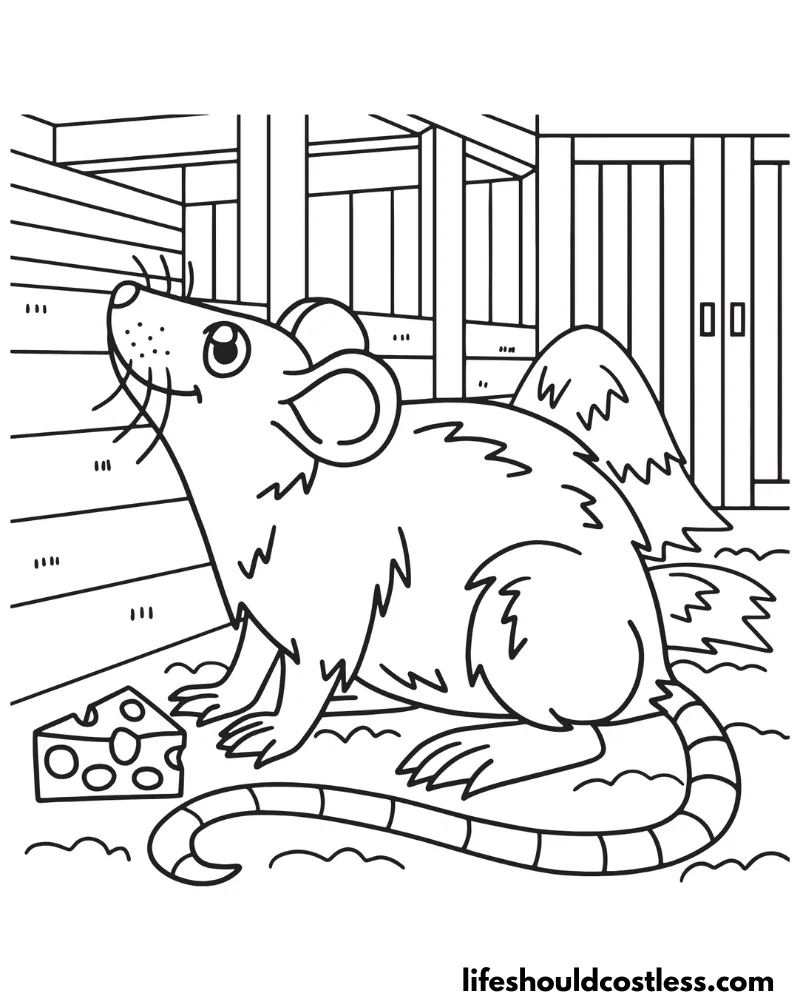
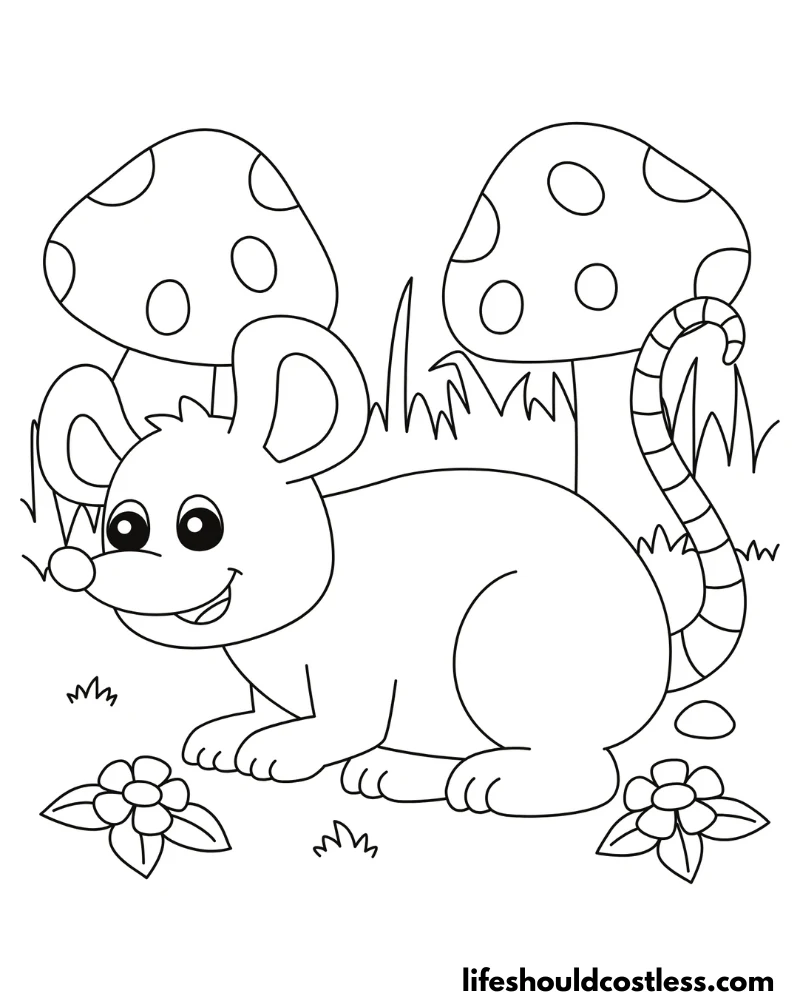
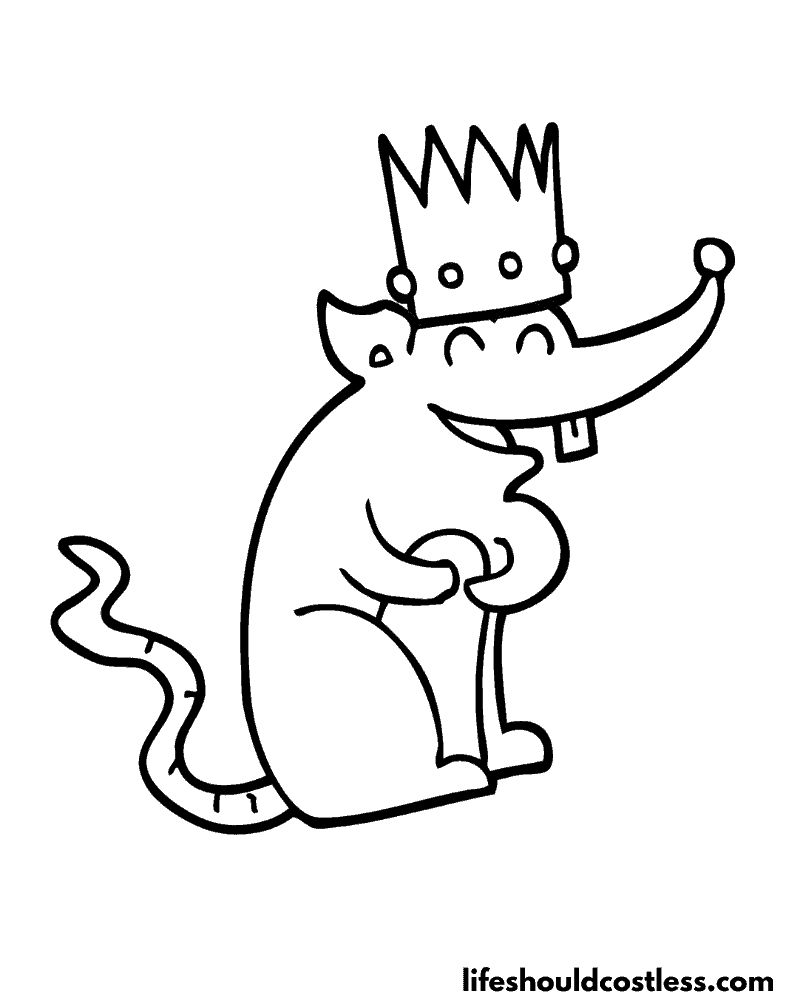
FAQ’s
Typically, wild or common rats, known as brown rats or Norway rats, have brownish-gray fur. This coloration allows them to blend into various urban and natural environments where they are commonly found.
However, the specific coloration of brown rats can vary somewhat, with shades ranging from light brown to dark gray. Their fur is generally uniform in color, with the belly being slightly lighter than the back.
The tail of a brown rat typically matches the color of its body, appearing brownish-gray as well.
It’s important to note that domesticated pet rats come in a wide range of colors and patterns due to selective breeding, while wild rats generally exhibit the typical brownish-gray coloration.
*I will add more rat colour / color questions and answers as the questions get sent to me.
Conclusion
In conclusion, the world of rat coloring pages invites us to embark on a delightful journey where creativity meets appreciation for these often underestimated creatures.
Through the strokes of our colored pencils and the choices of vibrant hues, we’ve explored not only the aesthetic allure of rats but also their remarkable diversity.
As we’ve entered into this artistic venture, we’ve uncovered the hidden beauty in the fur patterns, whiskers, and expressions of rats.
These coloring pages serve as a unique window into the world of these intelligent and adaptable animals, offering an opportunity not just for coloring but for learning and understanding as well.
What’s particularly fun about coloring these rat pages is their versatility. They serve as a canvas for self-expression, an educational tool, and a source of entertainment for artists of all ages.
Whether you’re a budding artist or a seasoned one, each page is a blank slate waiting for your imaginative touch.
These coloring pages can also spark inspiration for various other creative pursuits, from embroidery to fine line tattoos, showcasing the enduring impact of rat-themed art on diverse artistic endeavors.
They remind us that beauty can be found in the most unexpected places, and that, through the simple act of coloring, we can uncover the charm and complexity of the natural world.
So, whether you’re an artist, a rat enthusiast, or simply looking for a relaxing and creative escape, these pages offer an engaging and enriching experience that celebrates the wonders of nature and the power of imagination.
Thanks so much for stopping by my blog and supporting my endeavors to make people’s lives a little easier/better/more affordable.
If you liked this post, or found it helpful in any way, please make sure to share it with your family, friends, and co-workers via social media.
Or you could even send them the direct link via email. Whichever way you choose to spread the love, I super appreciate it! ~Sarah

How To Follow & Support This Site
- If you would like to subscribe to my email list, go here.
- Make sure to follow along via social media, by going here.
- If you would like to learn how to really show your support to this site (at no cost to you), go here.
- If you would like to make a direct donation to the site, go here.
Check out my other free printables
- To see all of my free printables, go here.
- If you would like to see an alphabetized index of free printable coloring pages, go here!
- All of my animals coloring pages are found here.
- Or, my other mammals coloring pages can be found here.
Otherwise, here are direct links to several of my other related posts that you’re also going to love:
Animals / Mammals
Animals / Birds
Animals / Insects
Other good resources for a printable rat
- https://www.dreamstime.com/illustration/rat-colouring-page.html
- https://www.coloringpages.org/cat-rat-497.htm
- https://www.edupics.com/coloring-page-rat-i10437.html
*This post was originally shared to this blog on 10/02/2023, and has since been updated to improve user experience, add video instruction, as well as to make it as shareable as possible across the social medias.
**Please note that I do try my hardest to provide factual, but easy to understand, information about each topic. If you notice a discrepancy in my coloring pages, facts, or see something that you deem “misinformation/incorrect” please make sure to notify me about it. I would prefer that you send me an email with a link to a more reputable resource on that subject, so that I can correct it as soon as possible. Thanks so much for helping this site become the best that it can be!
***Resources from djinkers were used in the production of this article.
***Resources from djinkers were used in the production of this article.
